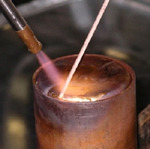
Brazing copper pipes using a oxyhydrogen gas generator system.
This technology works only with water and electricity. Gas is generated through a particular electrolytic cell, able to get H2-O2from the water. The gas produced comes out in a single pipe, perfectly mixed, without need for adjustment of the two gases. The flame has a perfect stoichiometric ratio of H2-O2.
The system, thanks to its characteristics, can bring significant advantages in safety and health, brazing quality, and cost savings. Moreover, the generator system is flexible and easily transported. Most are equipped with wheels for ease of movement. Applications for this brazing technology include refrigeration and air conditioning, electric motors, transformers, and others.
SAFETY AND HEALTH
A big advantage of the oxyhydrogen gas generator system is that it eliminates the usage of cylinders and the possibility of explosion.The flame is environmentally friendly and operator friendly. The combustion of hydrogen and oxygen produces water vapor and does not produce CO2emissions, resulting in a better working environment for the brazing operator. The operator does not need to wear dark brazing safety glasses, and fumes are reduced about 60 to 70 percent compared to traditional brazing.
The gas pressure inside the oxyhydrogen gas generator can be very low (less than 10 psi), which is below any safety standard regulation.
There is no hydrogen storage; the machine produces gas on demand.

Using the system to make copper-to-copper connections.
QUALITY
The flame is neutral and concentrated. Heat is therefore localized and does not spread, to help eliminate the risk of overheating the brazing piece and nearby components. Such a flame significantly reduces oxidation inside brazed pipes. For the refrigeration and air conditioning industry, less oxidation inside copper tubing results in extended life for the compressor.Thanks to the neutral flame and high temperature (3650°C), the brazing alloy penetrates deeper into the joint to produce a stronger connection.
The two gases are mixed automatically by the machine, eliminating human intervention. The flame’s quality is always consistent, therefore the quality of brazing improves accordingly.
COST SAVINGS
The oxyhydrogen system generates gas for brazing from distilled water and electrical current, nothing else. The user saves on:• Cost of gas (costs of gas are rising).
• Cost of cylinder rental and transportation.
• Cost to train operators to set the gas mixture with a conventional torch.
Also, with the oxyhydrogen system, the torch is ergonomically designed and lightweight (about half the weight of a conventional torch), which improves operator productivity. And due to the flame’s high temperature, brazing temperature is reached two to three times faster compared with conventional brazing, again improving productivity.
The result of these benefits is that cost savings of as much as 80 percent can be achieved over traditional brazing.
The oxyhydrogen gas generator system is not well known yet, but with all its advantages it merits a closer look.
Publication date:10/04/2010

Report Abusive Comment